
How to Seal the Deal: The Pro Guide to Closing Sales
How to Seal the Deal: The Pro Guide to Closing Sales
A step-by-step playbook on how to finalize sales after you make your pitch.
Introduction
The Deal Isn't Done Until It's Done
You’ve spent hours finding prospects for your sales pitch. You’ve prepared slides, brochures, and figures. Relentlessly followed up to get a meeting. Delivered your pitch to the right people . . .
. . . but your job isn’t done yet.
Now comes one of the hardest parts of the sales process: sealing the deal.
This is where you show your value as a sales professional. Your decisions here will either close the deal or lose it. The pressure is on, and you need to deliver.
To finalize a deal after making your pitch, you’ll have to do four things: overcome objections, create a sense of urgency, work out the specifics, and send the perfect proposal.
This ebook will walk you through each phase. We’ll start with objections.

Dealing with Objections
Prospects bring up objections, and you have to overcome those objections before the prospects convert to customers.
RAIN Group calls a sales objection “an explicit expression by a buyer that a barrier exists between the current situation and what needs to be satisfied before buying from you.”
It’s good to think about sales objections from this perspective. The client isn’t telling you “no.” They’re telling you that something is standing in the way of the sale. And if you can remove that obstacle, you’ll be one step closer to sealing the deal.
Want to overcome objections? Keep these tips in mind.
An objection isn’t a “no”
It’s easy to hear an objection and think that your prospect has just turned you down. But that isn't always the case. They’re telling you what’s standing in their way. Sometimes that barrier will be insurmountable.
That’s okay. You won’t make every sale.
But you’ll often find that you can handle the objection. You can answer a tough question, or make a compromise, or emphasize the value of your product in a new way. And that will get you the sale.
Don’t get discouraged if your prospect brings up an objection. It’s part of the sales process, and you need to be ready for it.
Tips for handling any objection
Different objections require different approaches to overcome. But you can adopt some good habits when it comes to objection handling that will help no matter what your customer is worried about.
Chris Orlob summarized a fantastic study by Gong.io about the habits of top-performing salespeople when they faced objections, and here are seven things they did better than average performers:
- Pause after the prospect raises an objection
- Ask questions when addressing objections
- Validate prospects’ objections
- Isolate the true objection to your pitch
- Get permission to address the objection
- Reframe the objection
- Finish handling objections with an unbiased resolution
You’ll notice that many of these tactics are simply good conversation skills. You should avoid rushing to share your side of the story, ask questions to get at the root of what your prospect is saying, and validate concerns in every conversation.
Remember that objections are opportunities. If the prospect doesn’t say “no” outright, they’re interested in what you have to say. Take advantage of that opportunity.
If you build these seven tactics into your objection-handling, you’ll close more deals.
Of course, that takes time and practice. Make a habit of doing each of these one at a time, and eventually build up to using them all. It sounds like a lot, but as you grow in your sales ability you’ll get better at each one.
How to handle 8 common sales objections
You can also prepare yourself to address specific objections to your pitch. Depending on your product, you might hear particular objections more (or less) often. Being ready for these objections ahead of time will help you stay confident during the conversation.
These eight sales objections are some of the most common across different industries. Here are some tips on how to handle them:
“It’s too expensive.”
Every salesperson deals with this objection. Many will find that it’s the most common. But don’t worry: this isn’t the death knell of your sales pitch. If your prospect says your product is too expensive, that means they’re interested in it. Just not at its current price.
Instead of getting discouraged, focus on this fact: your prospect doesn’t fully understand the value of your product. You wouldn’t be selling at this price if it wasn’t worth it.
So emphasize value to deal with this objection. Share a case study that shows a company saving lots of money after buying your product. Or compare it to a competitor’s offering and show how much more valuable it is.
Make your prospect understand that they’re getting a great deal for what you’re selling.
“We don’t have the budget.”
This objection is related to—but distinct from—the objection that your product is too expensive. It might sound like a “no,” but it’s a positive reaction. Because the prospect isn’t saying they don’t understand the value. Just that they can’t swing it right now.
So give whatever help you can. Can you offer a lower price for an introductory period? Present a different type of contract that might work for a short period of time?
Or maybe you can offer to get back in touch when the prospect’s budget resets. What’s important here is to not give up just because the company can’t afford it at the moment. This is a positive response—don’t let it go!
“I don’t want a contract.”
With many products and services switching to subscription pricing, you might hear this one often. Some prospects just don’t want to sign up for a contract. To deal with this objection, try similar tactics to the previous objections.
Emphasize the value of the subscription. Let your customer know that you can offer a better deal through a subscription model. If you think the contract could be a dealbreaker—and you’re able to offer a better deal—do it. Offer to waive the sign-up fee or give the prospect a shorter introductory contract term.
This is a difficult objection to deal with. Your best bet is to point out that the prospect will get more value from a contract with you than they would from buying a similar product outright. Spend some time figuring out the best way to address this objection for your company.
“I’m in a contract with a competitor.”
The first thing you need to figure out in this situation is whether the prospect is happy with that competitor. If they’re not, you’re in a good position: you just have to determine how to make breaking that contract worth the money and effort it takes to do so.
Maybe you can offer enough of a discount to offset the cost of breaking the contract. Or your contract is so much cheaper that it will pay off in a year. If you can show that breaking the contract is a good idea, the sale is yours.
If you can’t demonstrate that breaking the contract is a good idea, find out when the prospect will start the process of determining whether to renew their contract. Don’t worry about the actual renewal date—by then the decision will have been made.
And if the prospect is happy with their current contract, use the advice for overcoming other objections (like the advice in the next section) to show them why your product or service is better.
“I can get it cheaper somewhere else.”
This is a common objection in software sales, where prospects can get a free version of almost anything. So you need to articulate why your product is better than the free or lower-priced alternatives.
Does it have more features? Better support? More detailed documentation? A more intuitive user interface?
If the cheaper option is your competitor, you’ll come back to value again. Why does your product offer better value? You should always be ready to talk about why your product is better than your competitors’.
Finally, you might get the feeling that the prospect is digging for a discount. Explain why your product is the best, and offer what you can, but be ready to walk away. You can’t give a discount to everyone who says they have a cheaper option available.
“I don’t want to change how I’ve been doing this.”
By selling your product or service to someone, you’re asking them to change how they do things. A product like new payroll software might be asking for a lot of changes, while a different phone carrier might be easier to adapt to. But either way, there’s change involved.
And that makes people nervous. Even after you’ve told them how your product will help them be more productive, make more money, or eliminate waste, they might not want to adopt it.
Case studies and testimonials are effective in these situations. Talk about a previous customer who had a system in place and didn’t want to change, but took the plunge anyway—and loved the result. Do you have a great support team that’ll help them get onboarded? Or is your product or service really easy to learn? Those facts can offset this concern too.
“I need to get buy-in from (or consult with) someone else.”
This is a tricky one. If your prospect is excited about your product, they might actually consult with their boss or purchasing team. But they might also be trying to get rid of you.
You have two options here. The first is to stay involved in the process. Suggest a meeting between you, the prospect, and the person or team they need to talk to. That way you have some control over the situation. You can sway the decision-maker.
Alternatively, you can ask to get in touch with the decision-maker yourself. Don’t make it sound like you’re trying to go over your prospect’s head or that you don’t trust them to make the case.
Instead, present it as doing a favor for them: “Why don’t I save you some time? If you put me in touch with your boss, I can give them an overview of our conversation and answer any questions they have.”
“Send me some information and I’ll get back to you.”
This might be a ploy to get you off the phone. But it might be a sincere request for more information so the prospect can make an informed decision. If you always assume the latter is true, you’ll get better results.
Every salesperson has an approach to this objection. There are lots of potential responses. But choosing the right one depends on many factors—is the customer saying this early in the call? Or late? Are they already qualified, or are you trying to find out if they’re a good fit for your company?
The answers to these questions determine how you approach the situation. For example, if the prospect isn’t yet qualified, you might try something like this:
“I can definitely do that! But before I do, I just want to make sure that I’m not wasting your time. Could you tell me about your concerns over your current HR software tool?”
That gets the prospect talking a bit more and should give you a better idea of how qualified they are. It also helps you figure out what information to send.
It might also cause the prospect to tell you more sternly that they have to get off the phone. In this case, you’ll have to make a judgment call whether to pursue the conversation further.
Be ready to compromise
Sometimes you can’t overcome a sales objection. Maybe a prospect isn’t willing to pay the price you’re asking for. Or they won’t buy without getting access to another feature.
To save the deal in this situation, you need to compromise. The important thing to remember is that compromise needs to be beneficial for both parties. That means your company still gets something out of it.
You might, for example, offer a discount in exchange for prepayment of a subscription fee. Or include an extra software license if the prospect agrees to a case study (remember that value to your company isn’t only represented by price).
Understanding when to compromise and to what degree you can offer incentives requires experience. But it’s a good idea to talk to your manager or supervisor to find out how much autonomy you have in this area.

How to Avoid Being Forgotten
How often do you hear these responses?
- “Let me think about it.”
- “We’re exploring all our options.”
- “We need to get approval from the higher-ups.”
Delaying the deal means you run the risk of being forgotten. But if the prospect feels a sense of urgency, they’re more likely to stay in touch with you and close the deal.
How do you communicate to the prospect that the deal is urgent? Here are a few options.
Offer a time-limited incentive
Incentives are the most common way to build a sense of urgency. If your customer only has a week to take advantage of a discount or get a free bonus, they’ll be more inclined to make a decision quickly.
This works well with prospects who already want to buy. They’re just not sure if right now is the best time, or if they can afford to pull the trigger soon. Saving 10% or getting a free license might be enough to convince them to take action more quickly.
But this isn’t always an option. So many salespeople use another time-honored tactic:
Get prospects excited about the sale
When prospects are excited about your product, they feel urgency without any input from you. Which saves you a lot of work and helps you seal the deal.
Ideally, your prospect is already excited about your product. If they’re not, however, or they’re only slighted excited, you have some work to do.
There are lots of ways to do this. Sometimes it’s as simple as letting your own excitement about your product show. You believe in your product—so tell your prospect that! Be confident that it’s going to change how they do business.
Case studies are a great related tool for getting prospects excited about your product. Tell them about how your product helped someone just like them to make a big change in their life or their business. Share how it made that customer feel, not just numbers. If someone said that your product was a lifesaver or that it revolutionized their business, tell your prospects that!
Some salespeople prefer to be very direct about getting people excited. They’ll ask the prospect a simple question, like “Jason, are you excited about saving your company time and money on payroll?” Sometimes it’s that easy. Just bring the benefits of the deal to the forefront. Once potential customers get talking about how the product will help them, they’ll often be more excited about getting started.
With some practice, you’ll find the methods that work for your product and sales style.
Emphasize scarcity
This is a proven tactic that salespeople use all the time. The human brain lights up when it senses that resources are scarce. And you can use that to your advantage.
Here’s how Amazon does it:
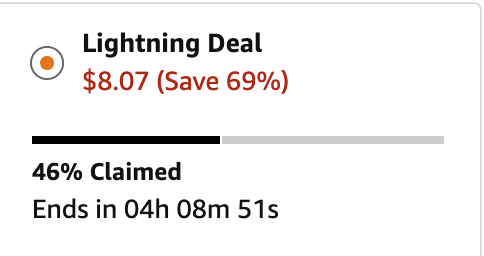
Amazon hopes that potential customers see this and say “46% claimed! I need to order before they’re gone!”
You might not be able to do the same thing, especially if you sell software or professional services. But if you work with your marketing department, you can find ways to create scarcity.
For example, you might decide to create a limited number of special packages that include 10 hours of free support. Now you can tell prospects that the next 15 people to sign up get this exclusive deal.
Even using the right words in your emails can make a difference. Words like “time-sensitive,” “limited,” “hurry,” and “limited-time” can boost your email open rate. It’s worth noting that, while spam filters have become much more advanced, they might still pick out these words as potential spam triggers. So use them in moderation and—when you can—use phrase variations that are less likely to get caught by spam filters.
For example, OptinMonster lists the following as some of the most effective email subject lines that they’ve seen:
- [URGENT] You’ve got ONE DAY to watch this... [from Digital Marketer]
- Mary, earn double points today only [from Jersey Mike’s Subs]
- Your 7-figure plan goes bye-bye at midnight… [from Digital Marketer]
- Flash. Sale. Alert [from HP]
- 25% off your favorites [from Guess]
As you can see, some of these subject lines use words and phrases that would traditionally be thought of a spam indicators. But because they’re sent from reputable sources, they not only get through the filters, but also get opened by readers.
Do some careful experimenting to find out how you can let prospects know that your incentive won’t last forever. No need to browbeat them with how urgent the sale is—consistently apply a bit of pressure, and you’ll get prospects to consider your offer quickly.
Follow up so they don’t forget
Being forgotten is the enemy of successful sales—and it’s hard for a prospect to be excited about your product if they’ve completely forgotten your conversation. So make sure to follow up.
Every organization and salesperson has a strategy for good sales follow-ups.Some send emails the next day. Others call a week later. Some have an entire workflow built on years of experience.
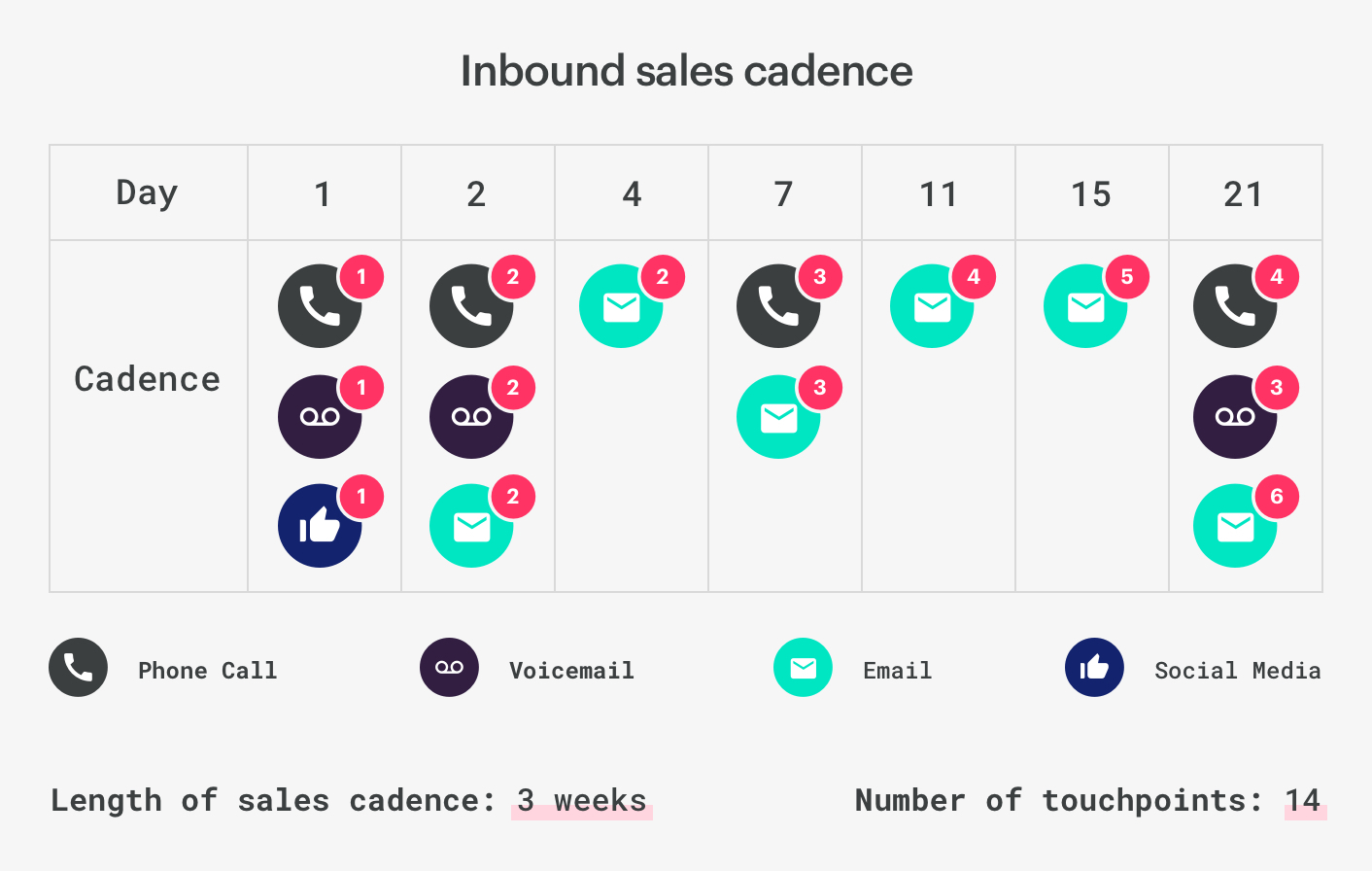
Here’s an example of an inbound sales cadence you can use to follow up with prospects
Find what works for you, and keep it simple. For example, you might use an email like this:
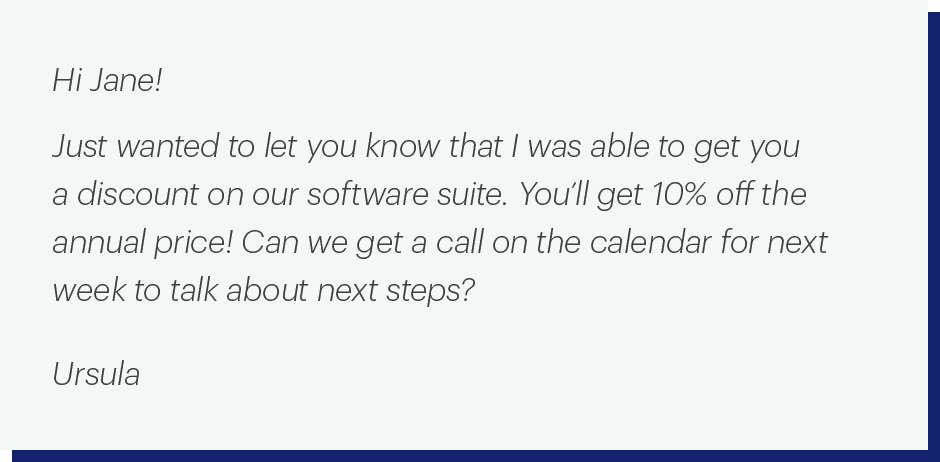
Discounts, case studies, blog content, and anything else you can send that’s valuable to your prospect will get them excited about working with you. And be sure to send follow-ups quickly, as 30–50% of sales go to the first vendor to follow up.
You can also tailor your email to the situation that led to the follow-up. Check out The Anatomy of the Perfect Sales Follow-Up Emails to learn more about different types of follow-ups!

Working out the Specifics of the Deal
There are a lot of things to keep in mind when you’re getting ready to send a proposal. By the time you get to this point, you’ve probably discussed pricing, payment terms, specific features, discounts, and more.
Skipping any one of these things in your proposal can put your deal on thin ice. Which is why it’s important to make sure you have an accurate record of everything you’ve talked about.
You’ll also need a record of what both parties need to do next. Is your prospect ready to see a proposal? Or do they need to get buy-in from their executive first? Were you supposed to pull information on other clients in your prospects’ industry for them?
All of this information needs to be captured in a central place so you know what you need to do and what you’ve discussed with your prospect.
You can do this in a few ways.
You could keep everything in your email account. Because a lot of sales communication takes place over email, this is a common tactic. With modern email search tools, you can find anything—if you remember what to search for.
You can also take notes, whether digitally or on paper. But this makes it even harder to find what you’re looking for. And if you have to share those notes, it’s going to be a challenge for another salesperson to get the information they need.
Your best bet is to record everything in a tool like a CRM.
CRMs make it easier to work out the details of a deal
When you store every piece of information related to a prospect in a CRM (like Copper), your job becomes much easier.
Your pricing negotiations are logged. You can quickly look up several different conversations with different people. Updated contact information is immediately at hand. Your notes can be sorted and filtered.
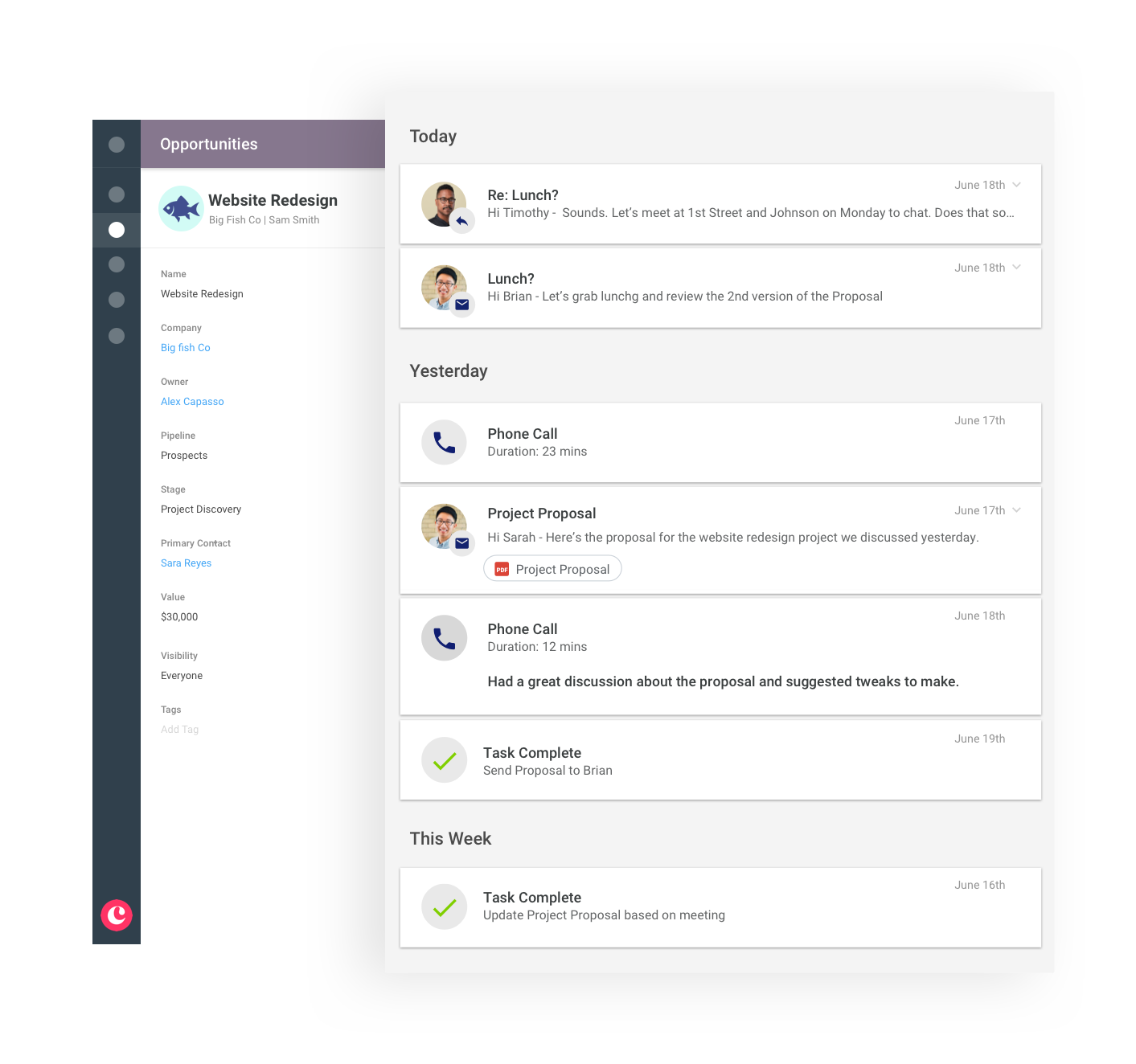
Copper logs your conversation history and interactions with prospects, so your entire team can easily track the status of any deal.
Having this information easily available means you’ll be better able to craft a proposal that your prospect wants to accept. And you’ll do it in less time. It’s also much easier when you’re in a team-selling environment (which is increasingly common in the Relationship Era).
In short, having a CRM during your sales process helps you close deals faster and more efficiently. Which means making more money.
Continue to be open to compromise
When you’re working out the details of a deal, you may find that prospects continue to push for compromises. They may ask for a discount one last time or request a specific feature that’s not usually in their level of subscription plan.
At this stage, there’s an even better chance that the prospect will go through with the deal even if you say “no.” But whether you want to bet on that is up to you. Sweetening the deal at this point might provide a better customer experience, but it could also reduce your profit margin.
Know what you’re allowed to give your customers to close a deal, and you’ll always know what kinds of compromises you can make.

Send a Signature Grabbing Proposal
When was the last time you took a hard look at the proposals you’re sending to your prospects and customers? We bet it’s been awhile.
Truth is, you can’t improve your sales process without looking at each and every step. Now that we’ve given you the tools to succeed at the final stages of your sales cycle, it’s time for one last step: sending that proposal.
There are a number of simple but immensely effective ways you can improve your sales document process. The biggest problem that most sales teams face today is that reps tend to over-focus on the proposal structure (the cover letter, pricing table, T&Cs) instead of the actual content.
It’s crucial at this stage to think about not only the how but also the what when it when it comes to crafting winning proposals.
Here are just a few tips to make your proposals more successful:
Keep things simple and crystal clear
Sounds obvious, right? But you would be amazed at how many salespeople forget this. When your proposal isn’t concise, you open yourself up to more questions, confusion, and headaches from your prospects.
Proposals should have clear headlines, a straightforward table of contents, and should be structured in a way so that your client moves through the content easily.
You should also consider where your potential buyer is in the sales cycle or buyer’s journey. Ask yourself, “How engaged is my recipient?”
Meaning, consider if your prospect could be evaluating other tools or services. If so, you’ll want to make sure your proposal is to-the-point and persuasive. Alternatively, if your prospect has already given you a verbal ‘yes,’ it might make sense for you to go ahead and include detailed legal terms with your proposal.
Introduce yourself
Remember, proposals are more than just showing off your product or service. One great way to connect with potential customers is to add a section where you describe your company and include short bios of your staff.
And don’t forget to include contact details in those staff bios. Clients may want to get in touch with specific individuals to ask questions or clarify any confusion.
This is also a great opportunity to show your customers who they’ll be working with on the project. Point out who their main point-of-contact will be and the team’s skills and experience. And don’t forget to include photos! It’s always great to put a face to a name.
Tailor the content to your customer
Everything in your proposal should be written with your prospect in mind. As you build the content in your proposal, take into account their pains, needs, and values.
There are plenty of opportunities (we’ll get to specific elements later) to emphasize your unique approach to solving your client’s problem, and why you are better than your competition for the job.
Even your team members’ biographies can achieve this. How do your company values reflect your prospect’s, for example? Which skills are most applicable to their problems? Do you have anything in common, like location, size, or past experience?
Restate the pain your prospect is experiencing
Gently remind potential clients of the problems they’re facing. It creates a need that can push them across the finish line faster. Where it’s appropriate, communicate your understanding of their problems and explain why you’re uniquely suited to solve them.
You may even want to dedicate a section of your proposal to outlining the client’s key problems. This will communicate to your prospect that you have total understanding of their situation and help foster confidence and trust.
Use rich media
Proposals with rich media are 32% more likely to close. Images, videos, charts, diagrams, and graphs are excellent ways to clarify key messages and support information in your proposal.
But don’t overdo it. You won’t want to include too many media-rich elements that your proposal becomes more confusing than a Sudoku puzzle.
One or two well-placed graphs, along with images for team bios, is more than enough for most proposals. Avoid stock images too. Make sure anything you use is original content created by you.
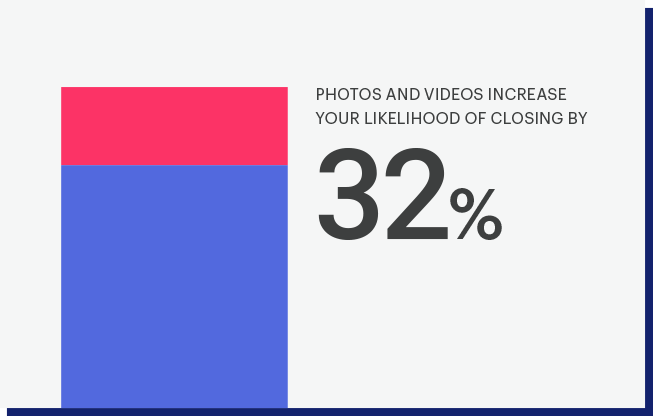
Explain why you’re better
Make no mistake, prospects will be checking out your competition as they’re evaluating you. Prospects often actively compare proposals, so keep in mind that a proposal doesn’t necessarily signify the deal is over—no matter how excited your prospect was on calls and emails.
Don’t bash or directly compare yourself to your competition; instead, point out the biggest strengths and advantages your company has over the others.
The best way to do this is to include a comparison matrix, any awards or industry accolades you have, or better yet, a killer case study or testimonial from your biggest client.
Reduce friction
There are many tools and technologies on the market today that make it easy for your prospects and customers to approve proposals.
Consider a paperless solution or adopting eSignatures as a way for clients to avoid printing, scanning, and emailing back your proposals. Make sure the terms and conditions of your agreement are clear and easy to understand.
8 essential elements of a winning proposal
Now that we’ve detailed some simple and effective ways to improve your proposals, it's time to get down to brass tacks and talk about the essential elements every proposal should include.
The elements we mention below apply to any industry and client—you should absolutely use them in every proposal you send, especially if you want to win more deals and increase your bottom line.
Let’s dive in.
1. Cover page
Like the cover of a book, the main purpose of a cover page is to give your proposal visual and professional appeal. Include your company logo along with the client’s name, your name and company, and the date.
This is the first thing your client will see when opening your proposal so it’s crucial to make a good impression and show off your brand.
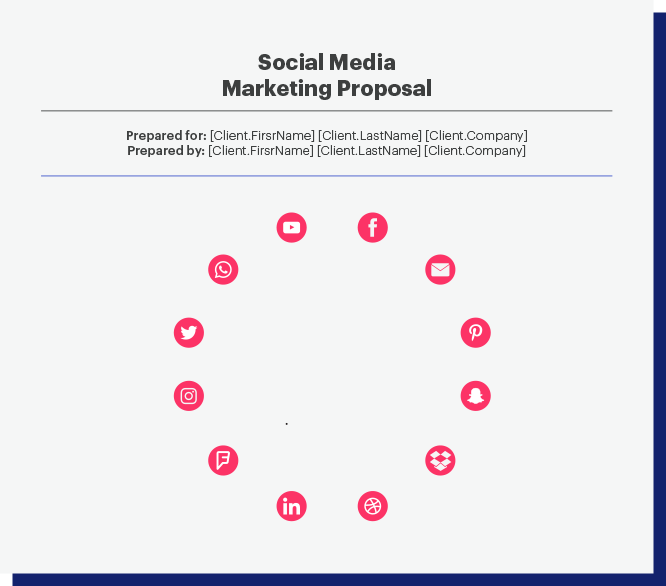
2. Table of contents
A table of contents is essential to make your proposal easy to navigate. It sets clear expectations right out of the gate and gives your reader an understanding of what to expect.
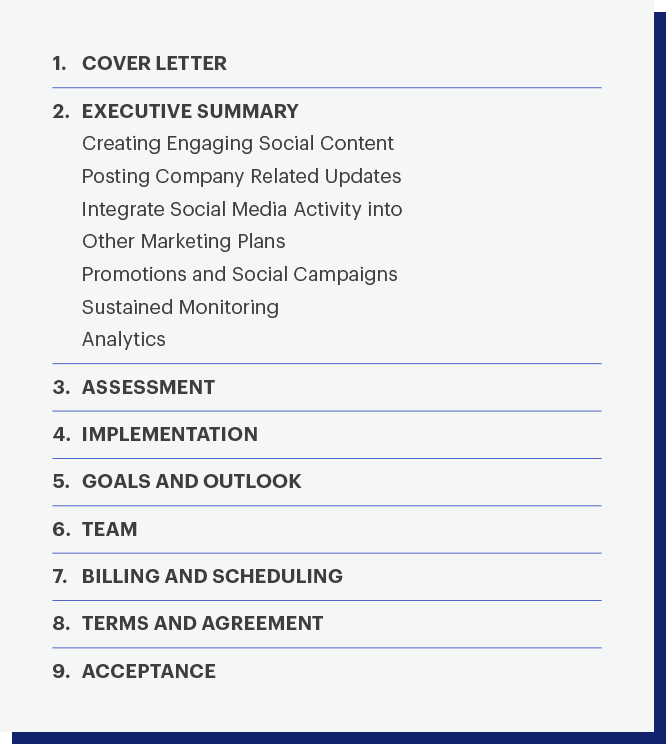
Particularly during the evaluation process, time-crunched buyers may want to navigate to a specific section (such as the pricing table) so they can compare your proposal to your competitor’s. Every sales cycle is different but if you’re sending a more detailed proposal, you should make it as easy as possible for your recipients to access important sections like legal content.
A table of contents is also helpful for people who want to revisit certain sections later—they can open your proposal again at any time and click right to where they left off.
3. Cover letter
A cover letter is like a welcome letter to your proposal. This section should include very simple information.
The cover letter is arguably the most important part of your entire proposal—and is often overlooked. This page will likely be seen by people who didn’t play a role in the earlier stages of the sales process, so it’s important to make an impact here.
The way to write an awesome cover letter is with personalization. Here are a few ways to do this:
- Summarize the customer’s goals with details about your company and solution.
- Reference your customer's account number, document number, or project name.
- Provide info on how your customer can reach the primary point of contact.
- Use your branded letterhead to strengthen the proposal experience.
- Keep it to a single page to allow the reader to quickly skim and absorb info.
4. Executive summary
Cover letters provide the reader with basic information, but the executive summary is the perfect opportunity to take a deep dive into your product or solution offering.
Use the knowledge you've uncovered in your research to develop powerful content that emphasizes the value you bring to the customer and projected outcomes. This section needs to be tightly focused and must clearly and succinctly describe how you plan to implement your solution.
Consider adding a timeline or timetable of deliverables and resources required. Start with a strong opening statement so that you set the stage for the results that your prospect can expect by using your solution.
In a nutshell: lay out the problem, need or goal; describe your proposed solution; explain how you'll overcome risks; paint a picture of the desired outcome.
5. “About Us”
Your cover letter kicked things off and gave your reader a preview of who you are as a company but the “About Us” section is where you can really show off what makes your business top dog.
Like we mentioned before, this is where you’ll want to include those team bios and photos. This is a great way to introduce your prospect to who they’ll be working with on the project and who their point of contact will be.
The About Us section is also where you’ll want to include info like past company successes, awards, and social proof in the form of testimonials or super-short customer case studies.
A great About Us section should be lively and reflect your company’s personality. Of course, if your industry has more serious clients, consider what is appropriate and what’s not.
6. Pricing table
If your reader has made it to this point in your proposal, then you’re in a good place. When a recipient reaches the pricing table, it usually means they’re already sold on the product or service that you’re offering. You’ve done your job of showing them that you understand their needs and now they’re ready to make the commitment.
This section is where you clearly define the costs with an easy-to-understand pricing breakdown of your offering. Be sure to also show the payment terms.
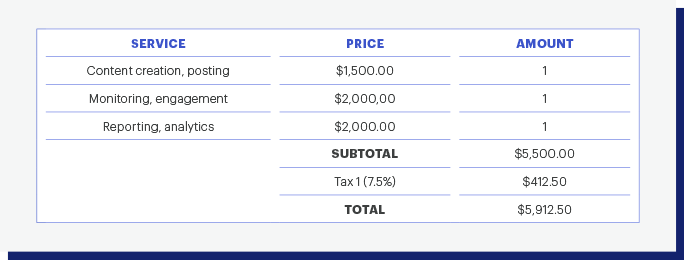
If you can, we highly encourage you to use an interactive pricing table where you can give your prospect the freedom to edit quantities, select products or services that best fit their budget, or even include optional items to increase your average sales price. Allowing your prospect to customize their solution gives them even more confidence in knowing they’ve chosen the right vendor.
7. Legal Ts & Cs
This is the portion of your proposal where you’ll get down to specifics. Give your prospect details (like the duration of the agreement), remind them of the overall timetable for completion, specify payment dates and types, when and how the proposal can be amended, and so on.
This is an overview of what you and the client are promising by agreeing to the proposal. Since it’s likely that you’ll need this section every time you send a proposal, you should consider storing it as a content library item so you can access it anytime and simplify the creation of future proposals.
Last and certainly not least, if you have an in-house legal team or a lawyer, you should review any terms and conditions with them first before adding them to your proposal. In most situations, standard legal copy will work for any prospect or customer.
Anyone that you do business with will probably need to get legal approval before agreeing to a proposal. So, make sure you include any necessary details like warranties, contingency plans, and payment terms.
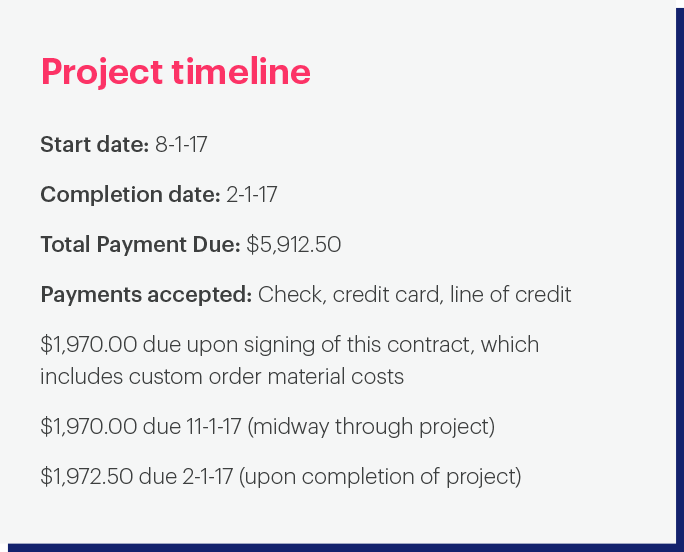
8. Call to action
You’ve made it! We’ve finally come to the last and final essential element of winning proposals.
Add a clear call-to-action at the end of your proposal. This is typically in the format of an electronic signature or easily clickable payment option. You might also consider adding your contact info so the reader can quickly give you a call if they have any immediate questions.
Something as simple as, “Sign below to approve this proposal,” is all you need. Whatever you choose, make sure it’s friendly and somewhat similar to what you included at the end of your cover letter. Sign off with a message like “Feel free to contact us with any questions and we look forward to working with you!”, then add your signature boxes, and you’re done!
It may seem like this structure is quite a task to take on. But to have a great proposal and to get it right requires a little legwork. Take every section into consideration when developing your perfect proposal. If something feels unnecessary or too repetitive, it’s okay to just leave it out.
Also do your homework. Research industry-specific templates to take the guesswork out of what’s standard and what’s not in your industry. Research can also help cut down on formatting time too.
By reusing some assets in the templates you find, like the about us and terms and conditions sections, will help you deliver polished proposals faster and ultimately close more deals.
Following up like a champ
Now that you’ve delivered your perfect proposal to your prospect, the real fun begins: the task of actually closing the deal.
Often this proves to be more difficult than it should be. You want to maintain the momentum of the deal without pestering or annoying your prospect into signing on the dotted line.
Here are a few tips to increase your chances of open communication and decrease the likelihood of your prospect ghosting you.
Ask for guidance
This might sound confusing but the only person who knows how to effectively follow up with the prospect is the prospect. So ask them.
As soon as you wrap up your last call (and before sending your proposal), ask your prospect how’d they like to stay in touch so you aren’t annoying them.
Ask questions like: “Is it okay if I touch base with you in two days? Does that give you enough time to review the proposal? If not, when should I reach out?”
Also, consider asking about their preferred way of communicating about the proposal. Is it email? Phone? Even texting could work.
Another idea is to suggest a specific subject line of your email so that you ensure you hear from them.
By setting expectations early and establishing a rhythm of communication, you’re continuing to add value to the sales process and hold your prospect accountable, which will help you build a stronger business relationship.
Define next steps early
You should never leave a call without a clearly defined next step scheduled on the calendar.
The easiest way to do this is to get the commitment at the end of the call. It’s very likely that your prospect will have their schedule in front of them and will be able to agree to a future date quickly.
Capitalize on the moment. Lock them down to a proposal follow-up call by asking when they can meet next. Then send a calendar invite while you’re still on the phone with them.
When you fail to leave without a commitment to review your proposal, you’re basically agreeing to chase after them and the odds of your proposal not getting signed will only increase.
Get written confirmation
Now that you’ve agreed to when and how you’ll follow up with your proposal, make sure the agreement is in writing. This ensures that your proposal follow-up remains focused on the value you’re bringing to the deal.
There are a few other reasons why this is beneficial for everyone:
- Most reps and prospects are running a million miles a minute and have a terrible memory. If you don’t immediately get the discussion down, you’ll likely forget.
- Writing things down also proves to your prospect that you understand their needs. You want to show them that you hear them loud and clear.
- Accountability. This is the most professional way to hold your prospects to their word that they’ll sign the proposal.
When you summarize the convo and receive confirmation, you accomplish everything above while staying on the same page.
Epilogue
Now that you’ve seen the four steps that you’ll need to take after making a pitch, you’re ready to go out and start closing deals. This information might feel overwhelming at first—there are a lot of things to think about.
But with practice, these steps will become a habit. You’ll record information in your CRM without even thinking about it, overcome objections automatically, and naturally elicit a sense of urgency in your prospects. And you’ll get in the habit of creating great sales proposals that encourage prospects to seal the deal quickly.
Successful salespeople include these things and more in their post-pitch sales process. With time, you’ll develop your own process that works for you.
Start with something small. For example, you might prepare to address a single objection before your next call. Then you can move onto addressing another objection on the next call. Or you might practice your pitch so it more effectively generates a sense of urgency. Or work on sending a better proposal.
If you continually improve yourself using the tips above, you’ll soon find that you’re sealing more deals.

Goodbye Data Entry
Hello Copper.
Try it free!
No credit card required. Start your 14-day free trial today.